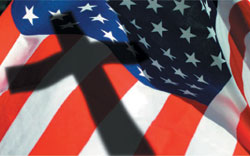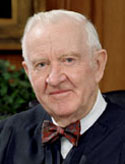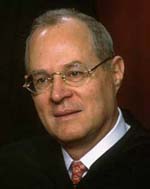In search of a ‘fixed star’

Courts split over church-state separation; divergence reflects public ambivalence
By Bruce T. Murray
Author, Religious Liberty in America: The First Amendment in Historical and Contemporary Perspective
- A federal district judge in Wisconsin ruled that the National Day of Prayer is unconstitutional; but the 9th Circuit Court of Appeal in California ruled that the Pledge of Allegiance – with the words “under God” – is constitutional.
- The Supreme Court signaled that a memorial cross in the Mojave Desert is constitutional; but the High Court ruled that displays of the Ten Commandments in local courthouses are unconstitutional.
- The Supreme Court ruled that prayers before state legislative sessions are constitutional, but a federal district court in Indiana ruled that the prayers before the Indiana legislature were overly sectarian, and thus unconstitutional. (A similar battle over this issue is playing out in Lancaster, Calif.)

The conflicting outcomes in these cases – and conflicting interpretations of the outcomes – reflect sharp divisions over the meaning of the First Amendment’s Establishment Clause — “Congress shall make no law respecting an establishment of religion.” The divisions in the courts reflect the disagreement in the broader society over the proper role of religion in American public life; and just how far church and state should be separated.
The conservative members of the Supreme Court, in particular, have taken offense at the Court’s decisions against certain forms of public religious expression. Justice Antonin Scalia said the Court’s decision barring benedictions at high school graduation ceremonies constituted a “jurisprudential disaster” (Lee v. Weisman, 1992); and Justice Clarence Thomas declared that the Court’s “Establishment Clause jurisprudence is in hopeless disarray.” (Rosenberger v. University of Virginia, 1995)
On the other hand, the liberal wing of the Court maintains the importance of upholding the separation of church and state:

“Whenever we remove a brick from the wall that was designed to separate religion and government, we increase the risk of religious strife and weaken the foundation of our democracy,” wrote Justice John Paul Stevens in the 2002 case, Zelman v. Simmons-Harris. (Stevens is set to retire from the Court at the end of its current session.)
These cases were decided by sharply divided courts. Most recently, the Mojave cross case was decided by a narrow 5-4 majority. A slight tilt on the Court’s composition could result in an entirely different outcome. Cases regarding Christmas holiday displays subdivide the Court still further.
The Court’s history and struggles with the meaning of the First Amendment are further examined in the Massachusetts Press book, Religious Liberty in America: The First Amendment in Historical and Contemporary Perspective by Bruce T. Murray.
“In the course of the book, Murray addresses the character and diversity of religion in the United States, the historical underpinnings of the First Amendment’s religion clauses, and the Supreme Court’s evolving interpretations of these provisions. He gives special attention to the views of the current justices, including the court’s most recent appointees, Chief Justice John Roberts and Justice Samuel Alito.”
—Daniel O. Conkle, Professor of Law and Adjunct Professor of Religious Studies, Indiana University (from the July, 2009 issue of the Catholic Historical Review).
Religious Liberty in America is available at libraries throughout North America, and it may be purchased from the University of Massachusetts Press.
Read about the author here.
Appendix
‘A subjunctive ruling’
The Supreme Court did not rule directly on the Establishment Clause issue in Salazar v. Buono; the Court's ruling focused on the patch of land underlying the cross – specifically whether the land was permissibility transferred from the federal government to the Veterans of Foreign Wars. The Supreme Court reversed the District Court's order prohibiting the transfer, and sent the case back to the lower court for further consideration.
However, the Supreme Court indicated how it would rule on the Establishment issue: Justice Anthony Kennedy, who wrote the opinion of the Court, stated that the placement of the cross on federal land did not constitute governmental “entanglement” or “endorsement” of religion. Rather, it was intended to honor the fallen World War I soldiers – inclusive of all of their creeds.
 “Although certainly a Christian symbol, the cross was not emplaced on Sunrise Rock to promote a Christian message,” Kennedy wrote. “Here, one Latin cross in the desert evokes far more than religion. It evokes thousands of small crosses in foreign fields marking the graves of Americans who fell in battles – battles whose tragedies are compounded if the fallen are forgotten.”
“Although certainly a Christian symbol, the cross was not emplaced on Sunrise Rock to promote a Christian message,” Kennedy wrote. “Here, one Latin cross in the desert evokes far more than religion. It evokes thousands of small crosses in foreign fields marking the graves of Americans who fell in battles – battles whose tragedies are compounded if the fallen are forgotten.”
Expounding on the broader constitutional issue, Kennedy wrote, “The goal of avoiding governmental endorsement does not require eradication of all religious symbols in the public realm. Rather, it leaves room to accommodate divergent values within a constitutionally permissible framework.”
Notes
Ceremonial deism
The courts distinguish between nonsectarian invocations, prayers to a particular deity, and “ceremonial deism.” However, municipalities that practice prayer before official meetings often cross the lines. The city of Lancaster, Calif., for example, has received numerous complaints about prayers “in the name of Jesus.” The ACLU has put the city on notice.
‘Fixed star’
“If there is any fixed star in our constitutional constellation, it is that no official, high or petty, can prescribe what shall be orthodox in politics, nationalism, religion, or other matters of opinion or force citizens to confess by word or act their faith therein.”
— Justice Robert Jackson, West Virginia State Board of Education v. Barnette (1943)
News annotations
More on religious symbols in the public square.

